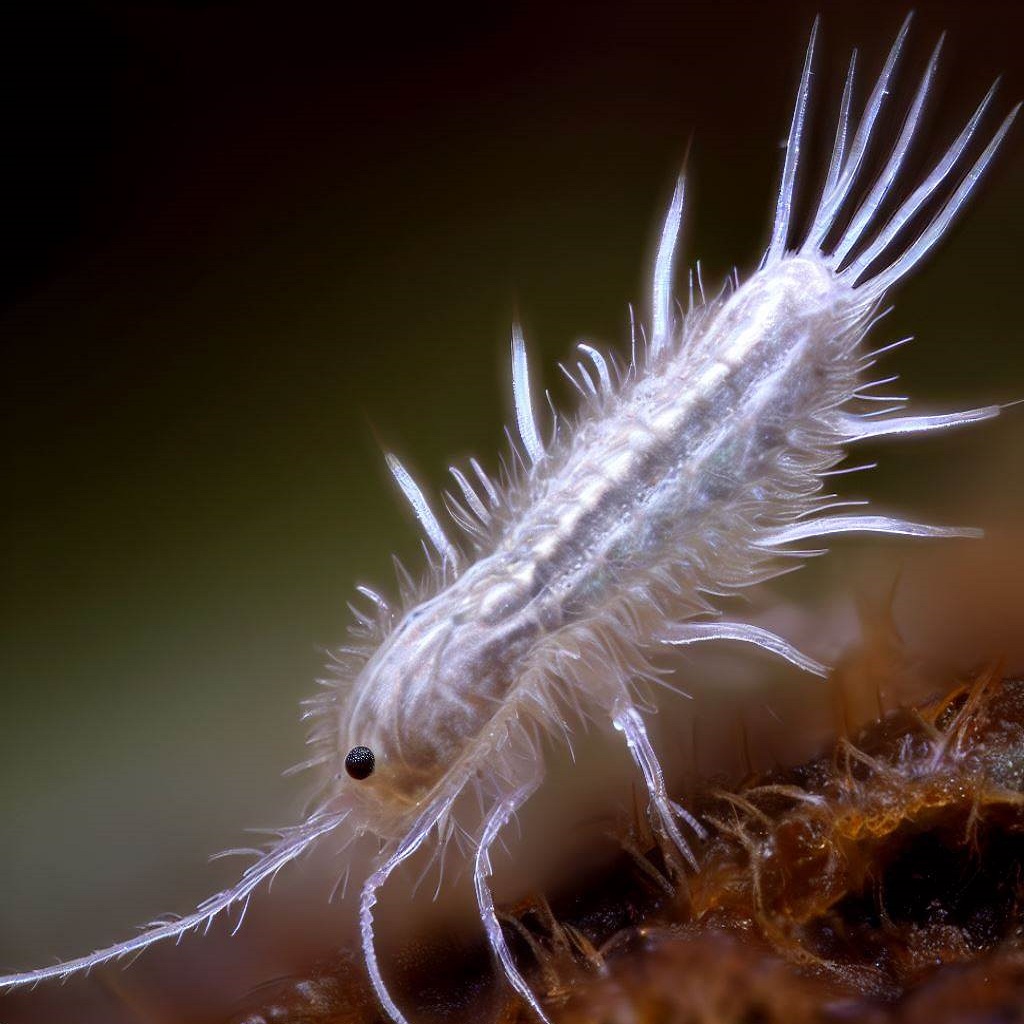Everything about Silverfish

| Everything About Silverfish | |
|---|---|
| Feature | Description |
| Classification | Order: Zygentoma (previously Thysanura) |
| Appearance | Silvery-blue scales, teardrop-shaped body, long antennae, three bristle-like appendages at the rear end. |
| Size | Generally 12-19 mm in length. |
| Preferred Habitat | Dark, damp environments like basements, bathrooms, attics, and kitchens. They thrive in high humidity. |
| Diet | Carbohydrates, especially sugars and starches. Known to consume book bindings, wallpaper glue, and some textiles. |
| Behavior | Nocturnal, quick-moving, and tend to avoid light. They reproduce in hidden locations. |
Dissecting Silverfish Anatomy
Silverfish (Lepisma saccharina) are ancient, wingless insects known for their fish-like appearance and movements. They belong to the order Zygentoma. Here’s a breakdown of their anatomy:
Head
Body
Internal Systems
Behavioral and Life History Traits
Head
- Antennae: Silverfish have long, thread-like antennae that are constantly moving and are used to sense their environment.
- Compound Eyes: Unlike some other Zygentoma species, silverfish have large compound eyes, though they aren’t particularly well-developed. Still, they’re not blind and will move away from light sources.
- Mouthparts: Silverfish have chewing mouthparts. Their diet consists of carbohydrates such as sugars, starches, and cellulose.
Body
- Terga: These are the dorsal plates on each body segment. Silverfish have a tough exoskeleton that provides some protection against desiccation (drying out).
- Cerci: Silverfish have three tail-like appendages at the end of their abdomen: two lateral cerci and one central filament. These structures are sensory in nature and help the silverfish navigate its environment.
- Legs: Silverfish have three pairs of legs, which are relatively short and positioned towards the front of the body. They’re known for their characteristic, wriggling movement, which looks somewhat like a fish’s movement—hence the name “silverfish.”
- Body Scales: The body of a silverfish is covered in tiny, shiny scales, which give it a silvery appearance.
Internal Systems
- Digestive System: Silverfish have a simple gut that runs from the mouth to the anus. They are capable of digesting cellulose, which is quite unusual for insects, and this allows them to feed on a variety of materials, including books and wallpaper.
- Circulatory System: Like other insects, silverfish have an open circulatory system. The primary component of their “blood” (hemolymph) is water, and it bathes the internal organs directly.
- Respiratory System: Silverfish respire through a series of tiny tubes called tracheae that transport oxygen directly to the body’s cells. Spiracles, small external openings, allow for gas exchange.
- Reproductive System: Male silverfish deposit sperm packets, which are picked up by females. After internal fertilization, the female lays her eggs in cracks or other hidden locations.
Behavioral and Life History Traits
- Molting: Silverfish continue to molt throughout their lives, even after reaching adulthood. This is somewhat unique, as most insects only molt during their immature stages.
- Habitat: They prefer dark, moist environments. That’s why they’re often found in bathrooms, basements, or kitchens.
- Lifespan: In ideal conditions, silverfish can live for several years.
How Do I Get Rid Of Silverfish?
Getting rid of silverfish involves addressing the humid environments they thrive in. By using Silverfish Control & Treatment methods, like desiccants or insecticidal dusts, you can tackle them effectively.
Regular home maintenance, like sealing gaps and fixing leaks, helps prevent their return. For persistent infestations, it’s wise to consult professionals specializing in Silverfish Control to ensure complete elimination and prevention.
What are the most common types of Silverfish in Canada?
Silverfish (Lepisma saccharina) are small, wingless insects that are often found in homes. In Canada, the most commonly encountered silverfish species is the common silverfish (Lepisma saccharina). However, there are other species of silverfish and silverfish-like insects, such as firebrats (Thermobia domestica), that might be found in Canadian homes, especially in warmer, moist areas like basements and bathrooms.
- Common Silverfish (Lepisma saccharina)
- Firebrats (Thermobia domestica)

Common Silverfish

Firebrats
Call us for a Free Silverfish Inspection
What are the characteristics of Common Silverfish?

| Characteristics of Common Silverfish | |
|---|---|
| Feature | Description |
| Size | Generally 12-19 mm in length. |
| Color | Silvery-blue scales, giving them a metallic appearance. |
| Shape | Teardrop-shaped body, with three long, thread-like tail appendages (two cerci and one terminal filament) and long antennae. |
| Habitat | Dark, damp environments like basements, bathrooms, attics, and kitchens. They thrive in areas with high humidity. |
| Diet | Carbohydrates, especially sugars and starches. Consumes materials like book bindings, wallpaper glue, and textiles. |
What are the characteristics of Firebrats?

| Characteristics of Firebrats | |
|---|---|
| Feature | Description |
| Size | About 1/2 inch (1.25 cm) in length. |
| Color | Mottled grayish or brownish color, with a spotted appearance. |
| Shape | Similar to silverfish: teardrop-shaped body with three long, thread-like tail appendages (two cerci and one terminal filament) and long antennae. |
| Habitat | Warm, humid environments. Commonly found near furnaces, boilers, and heated buildings since they prefer temperatures above 90°F (32°C). |
| Diet | Carbohydrates, especially starches and dextrin. They'll eat wallpaper paste, book bindings, paper, photos, and even some textiles. |
Call us for a Free Silverfish Inspection
Top Tips To Prevent Silverfish Infestations: Essential Guide
- Control Humidity: Silverfish thrive in damp environments. By investing in dehumidifiers and ensuring good ventilation in areas like basements, attics, and bathrooms, you can make your home less appealing to them. Always fix any leaky pipes or faucets promptly to avoid creating moist conditions.
- Seal Entry Points: Ensure that silverfish can’t easily enter your home by sealing cracks and crevices in the foundation, walls, and around windows and doors. Using caulk or other sealants, close any gaps and openings that might allow them access.
- Proper Storage: Books, papers, and clothing are potential food sources for silverfish. Store these items in well-sealed plastic containers or in rooms with low humidity. Additionally, avoid leaving piles of newspaper, cardboard, or other materials they might be attracted to lying around for extended periods.
Frequently Asked Questions about Silverfish
Silverfish are not directly harmful to humans in terms of health, as they do not bite or carry diseases. However, they can cause allergenic reactions in some people and are pests that can damage books, wallpapers, clothing, and other starchy materials
Silverfish are attracted to damp, humid environments, often found in bathrooms, basements, attics, and kitchens. They can enter homes through cracks, vents, or gaps. Inside the house, they are usually drawn to paper and damp clothing. Their presence might indicate a moisture problem in the home.
To get rid of silverfish, reduce humidity with dehumidifiers, fix leaks, and improve ventilation in damp areas. Store books and clothing in sealed containers, and vacuum regularly to remove food sources and eggs. If infestations persist, consider consulting with a pest control professional.
